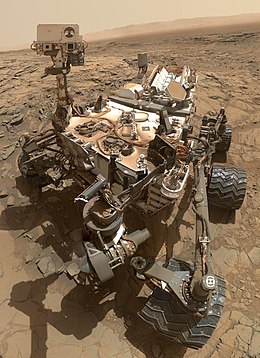Curiosity (rover)

Self-portrait of Curiosity located at the foothill of Mount Sharp (October 6, 2015)
|
|
| Mission type | Mars rover |
|---|---|
| Operator | NASA |
| COSPAR ID | 2011-070A |
| SATCAT № | 37936 |
| Website | mars |
| Mission duration | Primary: 668 sols (687 days) Current: 1603 sols (1646 days) since landing |
| Spacecraft properties | |
| Manufacturer | |
| Dry mass | Rover only: 899 kg (1,982 lb) |
| Start of mission | |
| Launch date | November 26, 2011, 15:02:00 UTC |
| Rocket | Atlas V 541 (AV-028) |
| Launch site | Cape Canaveral LC-41 |
| Orbital parameters | |
| Reference system | Heliocentric (transfer) |
| Mars rover | |
| Spacecraft component | Rover |
| Landing date | August 6, 2012, 05:17:57 UTC SCET MSD 49269 05:53:28 AMT |
| Landing site |
Aeolis Palus ("Bradbury Landing") in Gale Crater (4°35′22″S 137°26′30″E / 4.5895°S 137.4417°E) |
| Distance covered | 15.30 km (9.51 mi) as of 22 January 2017[update] |
|
Mars rovers (NASA)
|
|
Curiosity is a car-sized robotic rover exploring Gale Crater on Mars as part of NASA's Mars Science Laboratory mission (MSL).Curiosity was launched from Cape Canaveral on November 26, 2011, at 15:02 UTC aboard the MSL spacecraft and landed on Aeolis Palus in Gale Crater on Mars on August 6, 2012, 05:17 UTC. The Bradbury Landing site was less than 2.4 km (1.5 mi) from the center of the rover's touchdown target after a 560 million km (350 million mi) journey. The rover's goals include: investigation of the Martian climate and geology; assessment of whether the selected field site inside Gale Crater has ever offered environmental conditions favorable for microbial life, including investigation of the role of water; and planetary habitability studies in preparation for future human exploration.
Curiosity's design will serve as the basis for the planned Mars 2020 rover. In December 2012, Curiosity's two-year mission was extended indefinitely. As of February 8, 2017, Curiosity has been on Mars for 1603 sols (1646 total days) since landing on August 6, 2012. (See current status.)
As established by the Mars Exploration Program, the main scientific goals of the MSL mission are to help determine whether Mars could ever have supported life, as well as determining the role of water, and to study the climate and geology of Mars. The mission will also help prepare for human exploration. To contribute to these goals, MSL has eight main scientific objectives:
...
Wikipedia
